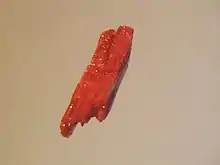Abelsonite
Abelsonite is a nickel porphyrin mineral with chemical formula C31H32N4Ni. It was discovered in 1969 in the U.S. State of Utah and described in 1975. The mineral is named after geochemist Philip H. Abelson. It is the only known crystalline geoporphyrin.
| Abelsonite | |
|---|---|
 Abelsonite from the Green River Formation, Uintah County, Utah, US | |
| General | |
| Category | Organic minerals |
| Formula (repeating unit) | C31H32N4Ni[1] |
| Strunz classification | 10.CA.20 |
| Dana classification | 50.4.9.1 |
| Crystal system | Triclinic |
| Space group | P1 (No. 2)[2] |
| Unit cell | a = 8.508, b = 11.185 Å c = 7.299 [Å], α = 90.85° β = 114.1°, γ = 79.99° Z = 1[1] |
| Identification | |
| Color | Pink-purple, dark greyish purple, pale purplish red, reddish brown |
| Cleavage | Probable on {111}[1] |
| Fracture | Fragile[3] |
| Mohs scale hardness | 2–3 |
| Luster | Adamantine, sub-metallic |
| Streak | Pink |
| Diaphaneity | Semitransparent[1] |
| Specific gravity | 1.45 |
| Optical properties | Biaxial[1] |
| Ultraviolet fluorescence | Non-fluorescent[3] |
| Absorption spectra | Strong reddish brown to reddish black[1] |
| References | [4] |
Description
Abelsonite is semitransparent and pink-purple, dark greyish purple, pale purplish red, or reddish brown in color.[1][4] The mineral occurs as thin laths or plates or small aggregates up to 1 cm (0.39 in).[1] The mineral is soluble in benzene and acetone and is insoluble in water, dilute hydrochloric acid, and dilute nitric acid.[5]
Occurrence and formation
The mineral is known only from the Parachute Creek Member of the Green River Formation.[6] It has been known from the Uinta Basin in Utah since its discovery and from the Piceance Basin in Colorado since 1985.[6] Abelsonite occurs in association with albite, analcime, dolomite, mica, orthoclase, pyrite, and quartz.[1]
Abelsonite is a secondary mineral that formed in fractures, vugs, and bedding planes of oil shale.[1][6] The mineral probably formed from diagenesis of chlorophyll, likely chlorophyll a, which was transported as an aqueous solution into a favorable geologic setting.[6][7]
In 2003, abelsonite was fully synthesized for the first time.[8]
Structure

In 1989, abelsonite was the only known geoporphyrin to have a crystalline structure.[6][lower-alpha 1] Most geoporphyrins occur as a series of homologues spanning a large range of carbon numbers.[6] The porphyrin which comprises abelsonite is common, but it does not usually occur in isolation from other porphyrins.[9]
The mineral is a deoxophylloerythroetioporphyrin (DPEP), with nickel occupying the center of the porphyrin ring. Most of the mineral consists of a C31 porphyrin with small quantities of a C30 norisomer.[10] The mineral crystallizes in the triclinic crystal system.[1]
History
The mineral was first noted in 1969 in a core sample made by the Western Oil Shale Corporation in Uintah County, Utah.[11] It was described in 1975 in the journal Geological Society of America Abstracts with Programs.[12] The mineral was named after Philip H. Abelson (1913–2004), a long-time editor of the journal Science,[6] for his work in organic geochemistry.[13]
Type specimens are held in The Natural History Museum in London and the National Museum of Natural History in Washington, D.C.[1]
Notes
- So far as the authors were aware[6]
References
- Anthony, John W.; Bideaux, Richard A.; Bladh, Kenneth W.; Nichols, Monte C. (eds.). "Abelsonite" (PDF). Handbook of Mineralogy. Chantilly, VA: Mineralogical Society of America.
- Hummer et al. 2017, pp. 1129-1132.
- "Abelsonite". Webmineral. Retrieved January 2, 2013.
- "Abelsonite". Mindat. Retrieved December 21, 2012.
- Milton et al. 1978, p. 932.
- Mason, Trudell & Branthaver 1989, p. 585.
- Mason, Trudell & Branthaver 1989, p. 594.
- Zhang & Lash 2003, p. 7253.
- Mason, Trudell & Branthaver 1989, p. 593.
- Storm et al. 1984, p. 1075.
- Milton et al. 1978, pp. 930–931.
- Fleischer, Michael (May–June 1976). "New Mineral Names" (PDF). American Mineralogist. 61 (5–6): 502.
- Milton et al. 1978, p. 931.
- Bibliography
- Hummer, D.R.; Noll, B.C.; Hazen, R.M.; Downs, R.T. (2017). "Crystal structure of abelsonite, the only known crystalline geoporphyrin". American Mineralogist. 102: 1129–1132.
- Mason, G. M.; Trudell, L. G.; Branthaver, J. F. (1989). "Review of the stratigraphic distribution and diagenetic history of abelsonite". Organic Geochemistry. 14 (6): 585–594. doi:10.1016/0146-6380(89)90038-7.CS1 maint: ref=harv (link) (subscription required)
- Milton, C.; Dwornik, E. J.; Estep-Barnes, P. A.; Finkelman, R. B.; Pabst, A.; Palmer, S. (September–October 1978). "Abelsonite, nickel porphyrin: A new mineral from the Green River Formation, Utah" (PDF). American Mineralogist. 63 (9–10): 930–937.CS1 maint: ref=harv (link)
- Storm, C. B.; Krane, J.; Skjetne, T.; Telnaes, N.; Branthaver, J. F.; Baker, E. W. (1984). "The structure of abelsonite". Science. 223 (4640): 1075–1076. doi:10.1126/science.223.4640.1075. JSTOR 1693019. PMID 17830155.CS1 maint: ref=harv (link) (subscription required)
- Zhang, B.; Lash, T. D. (September 2003). "Total synthesis of the porphyrin mineral abelsonite and related petroporphyrins with five-membered exocyclic rings". Tetrahedron Letters. 44 (39): 7253–7256. doi:10.1016/j.tetlet.2003.08.007.CS1 maint: ref=harv (link) (subscription required)
External links
| Wikimedia Commons has media related to Abelsonite. |
| Look up abelsonite in Wiktionary, the free dictionary. |
- Images of abelsonite from mindat.org